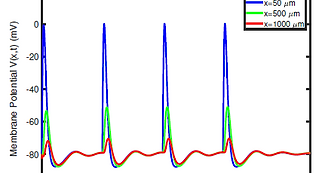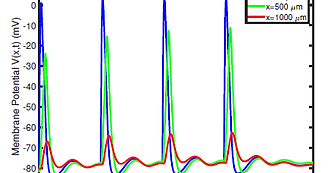Volume 2 Issue 2 ( August 2023)

REVIEW
An important new chapter in Neuroscience
Henry C. Tuckwell
Neuroscience began an important new chapter in the 1980s when it was demonstrated that the induction of cFos occurred in response to the stimulation of acetylcholine receptors in neuron-like cells. Transcription of cfos commenced within minutes and involved an influx of extracellular Ca2+ through voltage-sensitive calcium channels. Neuronal activity in many neuron types and brain regions led to the induction of many genes on various time scales. The first to be activated were immediate early genes (IEGs), including the Fos family cfos, fosB, fra1, fra2, and several isoforms. A short form of fosB called ΔFosB resisted degradation and was thought to play a role in inducing changes in addiction-related neurons. The protein products of many IEGs act as transcription factors important in neurons of the central nervous system for their roles in neuronal plasticity, exemplified by learning and memory, addiction and several neuropsychiatric disorders such as depression. This article describes experimental data and the biochemical processes underlying the pathways that lead to such transcription as a prelude to modeling.
PERSPECTIVE
The act of understanding uncertainty is consciousness
Roman R. Poznanski, Jan Holmgren, Lleuvelyn A. Cacha, Eda Alemdar and Erkki J. Brändas
We define precognitive affect, composed of information holding dispositional states, as noncontextual, rudimentary building blocks of subjective intentionality. We take on a psychodynamic approach to intentional agency. Intentions unfold into actions in animate thermodynamics reducing subjective uncertainty by negentropic action. They are intentions in action carrying meaning in species having complex protein interactions with various regulated gene sets. In particular, the unfolding of intentionality in terms of biological purpose introduced by subjective functioning allows for a satisfactory account of subjective intentionality. The underlying experience of acting paves the way for understanding meaning of precognitive affect from subjective functioning. Therefore, the brain’s subjective intentionality as the underlying experience of acting is embedded in a negentropic “consciousness code” of “hidden” thermodynamic energy. It is the negentropically-derived quantum potential energy in the unified functioning of brain consciousness at the macroscopic scale. While at the mesoscopic scale, Schrödinger processes create boundary conditions for negentropic action to inform the intentional agency.


REVIEW
On brain criticality in the context of resonance
Gerry Leisman
Biofields integrate several physiological levels temporally and spatially. Physiological coherence complements metabolic processes, which preserve animal cellular and physiological function. Coherent physiology involves internal biological system coordination and sensitivity to specific stimuli and signal frequencies. Current research shows that exogenous biologically and non-biologically generated energy entrains human physiological systems. Electrical and magnetic field measurements during physiological activity may occur from metabolic processes or unknown physiological actions. All living things resonate at similar or coherent frequencies; therefore, species will eventually share resonance. Resonance is a term closely related to awareness, interregional connections or disconnection in the brain, and the integratory function of the brain. It can describe synchrony, vibration, or harmony more broadly. The synchronized electrical cycles of the brain have similar resonance patterns. Resonance's significance in fostering integrated brain activity, awareness, awakeness and death are reviewed.
PERSPECTIVE
Infoautopoiesis and Consciousness
Jaime F. Cárdenas-García
The process of infoautopoiesis (info = information; auto = self; poiesis = production), a self-referential, sensory commensurable, recursive and interactive homeorhetic feedback process immanent to Bateson’s difference which makes a difference. Infoautopoiesis as a sensation information-action-sensation... process is at the center of resolving the fundamental problem of information, engaging all humans in their efforts to satisfy their physiological (internal/external) and relational needs, elucidating how they interact with their environment and how these interactions are constitutive of information generation, information exchange, information relations and life.


BRIEF REPORT
The Superfluid Vacuum and the neural nature of the Universe
Sabato Scala
5
Recent experiments seem to confirm the Bohmian interpretation of quantum mechanics by supporting the hypothesis of the existence of what Bohm called "pilot waves”, but numerous clues coming from the world of scientific research, suggest the existence of what Prigogine identified as the "world behind the scenes" that seems to underlie quantum phenomena; in particular, life related phenomena have anti-entropic behaviors opposite to those typical of classical thermodynamics, showing increases in the degree of order coexisting with the absorption of energy from the environment. If we limited ourselves to the physics of the macroscopic world, except not wanting to admit the existence of "delayed potentials" or "feedbacks" that travel in the opposite direction to that of propagation of the phenomenon, or even through an inversion of the "cause- effect" and of time, as proposed by the "syntropic”mechanism theorized by Luigi Fantappié, it is necessary to look elsewhere for the origin of these behaviors. In this article, starting from recent studies on the superfluid nature of vacuum , taking into account the possibility of a description of polar superfluids through an Ising model, or through a Spin Glass model, and the relative connection of these mathematical models with Hopfield's neural networks, the possibility is suggested that quantum phenomena are connected to an emergent behavior of the void that can be explained through ...
ORIGINAL RESEARCH
Backpropagation and repetitive discharge of sodium spikes in sparsely excitable dendrites
Nicolangelo L. Iannella and Roman R. Poznanski
We derive an approximate analytical solution of a nonlinear cable equation describing the backpropagation of action potentials in sparsely excitable dendrites with clusters of transiently activating, TTX-sensitive Na+ channels of low density, discretely distributed as point sources of transmembrane current along a continuous (non-segmented) passive cable structure. Each cluster or hotspot, corresponding to a mesoscopic level description of Na+ ion channels, included known cumulative inactivation kinetics observed at the microscopic level. In such a reduced third-order system, the ‘recovery’ variable is an electrogenic sodium-pump and/or a Na+-Ca2+ exchanger imbedded in the passive membrane, and a high leakage conductance stabilizes the system. A nonlinear cable equation was used to investigate back-propagation and repetitive activity of action potentials, exhibiting characteristics of the modified Hodgkin-Huxley kinetics (in the presence of suprathreshold input). In particular, a time-dependent analytical solution was obtained through a perturbation expansion of the membrane potential (V) for all voltage dependent terms including the voltage dependent Na+ activation (m) and state-dependent inactivation (h) gating variables and then solving the resulting system of integral equations. It was shown that back-propagating action potentials attenuate in amplitude dependent on the discrete and low-density distributions of transient Na+



.png)